$AI3 IS NOW LIVE ON: Kraken, KuCoin, MEXC, BitMart, & XT
The Subspace Foundation is excited to share the day-one listing partners for Autonomys Network’s native asset, $AI3: Kraken, KuCoin, MEXC, BitMart, and XT.
With the activation of native $AI3 token transfers initiating Mainnet Phase-2 and the release of Domains — a new class of decoupled execution environments starting with the Auto EVM Domain — Autonomys Network has officially stepped into a new era of growth, defined by expanded market access and stronger institutional alignment.
Built from first principles for permanence, verifiability, and scale, Autonomys provides the foundation for human-centric decentralized AI, with the goal of advancing quality of life through conscientious technology. As the next billion AI agents come online, Autonomys has taken an active stance to ensure this technology serves humanity broadly by lowering participation barriers. The network is live and ready for builders, with the Subspace Foundation Grants Program now accepting applications to support the long-term health and expansion of the network. $AI3 is the token that ensures all participants are recognized for their contributions and active role in Autonomys Network.
Where $AI3 is Listed
Kraken

Deposits: Open
Listing Date: August 27th, 2025
Listing Time (UTC): 14:00 UTC
Trading Pair: $AI3/USD
MEXC

Deposits: Open
Listing Date: August 27th, 2025
Listing Time (UTC): 14:00 UTC
Trading in Innovation Zone: $AI3/USDT
Withdrawal: Aug 28, 2025, 14:00 UTC
Convert: Aug 28, 2025, 15:00 UTC
KuCoin

Deposits: Open
Call Auction: From 13:00 to 14:00 on August 27, 2025 UTC
Trading: 14:00 on August 27, 2025 UTC
Withdrawals: 10:00 on August 28, 2025 UTC
Trading Pair: $AI3/USDT
BitMart

Deposit: Open
Trading: August 27th, 14:00 UTC
Withdrawal: August 28th 15:00 UTC
Trading Pair: $AI3/USDT
Register on BitMart: https://t.co/OvD9tAjZYV
Trading Zone: AI
Learn more about $AI3 on BitMart: https://bitmart.zendesk.com/hc/en-us/articles/40424189031707--Primary-Listing-BitMart-Will-List-Autonomys-AI3-2025-08-27
XT
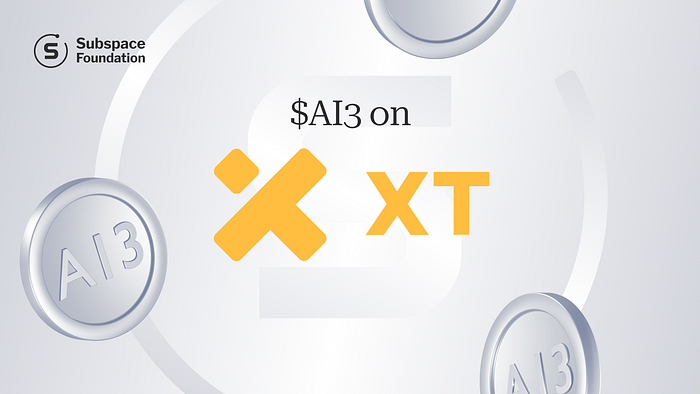
Deposits: Open
Listing Date: August 27th, 2025
Listing Time (UTC): 14:00 UTC
Trading Zone: Mining Coin Zone
Trading Pair: $AI3/USDT
What’s Happening Now at Autonomys
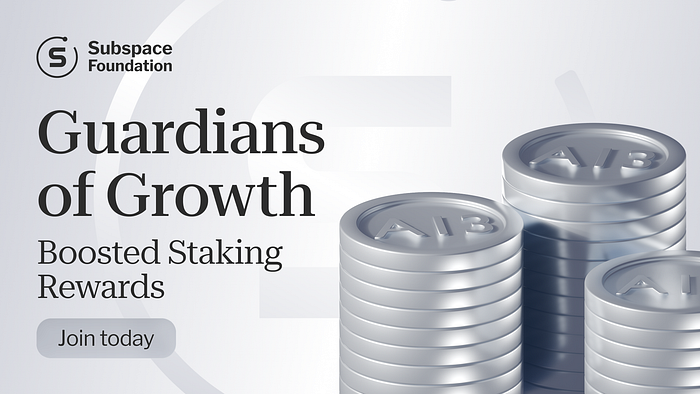
The listing of $AI3 on these leading exchanges marks a major milestone in Autonomys’ journey. With broader market access and institutional-grade platforms, Autonomys is accelerating the adoption of decentralized AI infrastructure and empowering builders worldwide. To strengthen security and decentralization from the very start, the Subspace Foundation has launched the Guardians of Growth Staking Bootstrap Program — an approximately 12-month, protocol-native phase with boosted staking rewards. We encourage community members to explore the program and take an active role in securing the future of the Autonomys Network. Stay tuned for additional campaign announcements and initiatives via our listing partners.
About Autonomys
The Autonomys Network — the foundation layer for AI3.0 — is a hyper-scalable decentralized AI (deAI) infrastructure stack encompassing high-throughput permanent distributed storage, data availability and access, and modular execution. Our deAI ecosystem provides all the essential components to build and deploy secure super dApps (AI-powered dApps) and on-chain agents, equipping them with advanced AI capabilities for dynamic and autonomous functionality.
X | LinkedIn | Discord | Telegram | Blog | Docs | GitHub | Forum | YouTube
$AI3 is Going Global: Listing August 27th on Kraken, KuCoin & MEXC
With the activation of native $AI3 token transfers initiating Mainnet Phase-2 and the release of Domains — a new class of decoupled execution environments starting with the Auto EVM Domain — Autonomys Network is entering a pivotal growth phase marked by greater global accessibility and institutional-grade liquidity. The Subspace Foundation is excited to announce that $AI3 will be initially listed on three prestigious exchanges — Kraken, KuCoin, and MEXC.
These listings signal the beginning of a truly global chapter for $AI3, opening doors for millions of users to participate, support network security, and help build the decentralized AI ecosystem.
Where $AI3 is Listed
Kraken
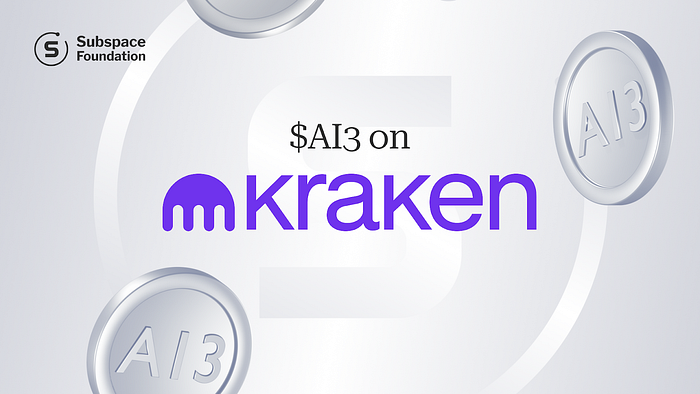
Founded in 2011, Kraken offers institutional-grade security, fiat support in seven currencies (USD, CAD, EUR, GBP, JPY, CHF, AUD), and over 780 trading pairs. Kraken processes over 40% of global stable-to-fiat trading volume among major centralized exchanges and serves over 4-million funded accounts, all while maintaining an unblemished security record. Kraken is recognized as one of the most trusted trading platforms worldwide.
Discover $AI3 on Kraken
Deposits: Open
Listing Date: August 27th, 2025
Listing Time: 14:00 (UTC)
Trading Pair: $AI3/USD
KuCoin
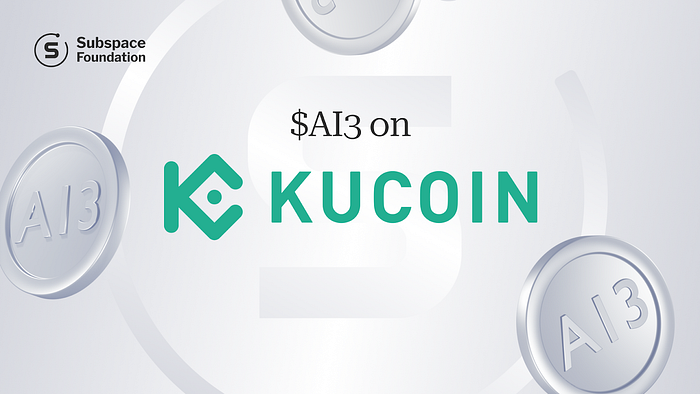
Founded in 2017, KuCoin is one of the pioneering and most globally recognized technology platforms supporting digital economies, built on a robust foundation of cutting-edge blockchain infrastructure, liquidity solutions, and an exceptional user experience. With a connected user base exceeding 41 million worldwide, KuCoin offers comprehensive digital asset solutions across wallets, trading, wealth management, payments, research, ventures, and AI-powered bots.
KuCoin has garnered accolades such as “Best Crypto Apps & Exchanges” by Forbes and has been recognized among the “Top 50 Global Unicorns” by Hurun in 2024. These recognitions reflect its commitment to user-centric principles and core values, which include integrity, accountability, collaboration, and a relentless pursuit of excellence.
Discover $AI3 on KuCoin
Deposits: Open
Call Auction: From 13:00 to 14:00 on August 27, 2025 (UTC)
Trading: 14:00 on August 27, 2025 (UTC)
Withdrawals: 10:00 on August 28, 2025 (UTC)
Trading Pair: $AI3/USDT
MEXC

Founded in 2018, MEXC is committed to being “Your Easiest Way to Crypto.” Serving over 40 million users across 170+ countries, MEXC is known for its broad selection of trending tokens, everyday airdrop opportunities, and low trading fees. Their user-friendly platform is designed to support both new traders and experienced investors, offering secure and efficient access to digital assets. MEXC prioritizes simplicity and innovation, making crypto trading more accessible and rewarding.
Discover $AI3 on MEXC
Deposits: Open
Listing Date: August 27th, 2025
Listing Time: 14:00 (UTC)
Trading in Innovation Zone: $AI3/USDT
Withdrawal: Aug 28, 2025, 14:00 (UTC)
Convert: Aug 28, 2025, 15:00 (UTC)
Looking Ahead

The listing of $AI3 on these leading exchanges marks another major milestone in Autonomys’ journey. With broader market access and institutional-grade platforms, Autonomys is accelerating the global adoption of decentralized AI infrastructure and empowering builders around the world. To further bootstrap the Autonomys ecosystem, the Subspace Foundation has announced the Guardians of Growth Staking Bootstrap Program — an approximately 12-month, protocol-native phase featuring boosted staking rewards to strengthen security and decentralization from day one. We invite all community members to explore and learn how you can play a role in securing the future of the Autonomys Network.
About Autonomys
The Autonomys Network — the foundation layer for AI3.0 — is a hyper-scalable decentralized AI (deAI) infrastructure stack encompassing high-throughput permanent distributed storage, data availability and access, and modular execution. Our deAI ecosystem provides all the essential components to build and deploy secure super dApps (AI-powered dApps) and on-chain agents, equipping them with advanced AI capabilities for dynamic and autonomous functionality.
X | LinkedIn | Discord | Telegram | Blog | Docs | GitHub | Forum | YouTube
Boosting Early Staking: The Guardians of Growth Initiative
This post is published on behalf of the Subspace Foundation, which is introducing the Guardians of Growth Staking Bootstrap Program as part of its mission to secure and decentralize the Autonomys Network.
At the launch of mainnet domains, the Autonomys Network will have relatively low transaction volume. Because staking rewards are derived solely from transaction fees and tips, nominators (stakers) and operators will initially experience lower returns.
While long-term sustainability will come from organic activity on Auto-EVM and other domains, it is essential to ensure that network security and decentralization are strong from day one. To bridge this early stage, the Subspace Foundation is implementing a temporary, treasury-funded incentive program.
Why this program exists
- Secure the network at launch: Ensure operators are rewarded even before organic fees reach critical mass.
- Encourage early staking: Enable holders to learn how staking works and begin participating in governance and security.
- Provide a temporary bootstrap measure: A time-bound subsidy using ~0.5% of the Foundation’s treasury, not a permanent change to network economics.
How the program works
The program leverages the existing protocol logic for distributing transaction fees.
- On a regular cadence, the Foundation submits a trivial transaction (a remark) on the Auto-EVM domain.
- Each transaction includes a tip, distributed exactly as any other user-submitted fee would be.
- Operators who execute and include these transactions in a block receive their share of the tip.
- Nominators (stakers) of those operators automatically receive their proportional share.
- All staking remains fully non-custodial — nominators retain complete control of their tokens at all times.
If you’re new to staking, check out our step-by-step guide to staking in the Autonomys docs.
Until permissionless operators are launched (expected next year), any fees earned by the Foundation’s own operators from this program will be recycled periodically back into the incentive stream, ensuring the incentives go entirely to the community.
This mechanism is implemented using the Operator Reward Distributor, an open-source service built in Node.js/TypeScript that:
- Sends a transaction at a steady interval (e.g., every N minutes).
- Attaches a configurable tip amount.
- Tracks budgets and confirmations in a local database.
- Supports RPC failover to ensure reliability.
This approach makes the program transparent, reproducible, and fully fully protocol-aligned.
Key features of the program
- Protocol-native rewards: Rewards are earned exactly like any other network activity. Once a transaction with a tip is sent, the protocol automatically distributes it through the standard fee system. No one decides who gets what — it’s all handled on-chain.
- Open and verifiable: Operators play an important role in block production, but they do not control the network. All activity can be checked and challenged, ensuring security remains in the hands of the broader community.
- Predictable yet flexible: Rewards are designed to flow at a steady, linear pace over ~12 months, with an initial ramp-up in tip size at the start. The Foundation may adjust cadence if needed to reflect network conditions, but the goal is a clear and transparent schedule.
- Time-bound: This is a bootstrap program, not a structural change. It is intended to last for ~12 months, after which operator earnings should be sustained by organic usage.
FAQ
Q: When does the program start?
The ramp-up phase will begin shortly after this announcement, with the goal of aligning closely to the exchange listings.
Q: Where do the funds come from?
From the Subspace Foundation treasury. This program allocates 0.5% of token supply to bootstrap staking incentives. Specifically, the near-term treasury will be used to fund operational wallets. You can find details of the address along with other official wallets in the forum post about them.
Q: How much will I earn if I stake?
There are no yield guarantees. Rewards will depend on (1) the cadence and size of tips funded by the Foundation, and (2) how many other nominators are staking. As more nominators join, each individual’s share naturally decreases.
Q: Isn’t this centralization?
No. The Foundation submits transactions, but the protocol handles distribution automatically. Nominators and operators earn exactly as they would from any normal transaction fee.
Q: How long will this last?
The program is designed to run for ~12 months, with rewards deployed in a steady, linear fashion. The Foundation may make minor adjustments if conditions change, but the total allocation will not exceed 5,000,000 AI3.
Q: What happens once permissionless operators are live?
The program will continue to function as designed. Tips will flow to all active operators and their nominators, permissioned or permissionless. This will make staking incentives even broader and more decentralized.
Q: How will I know what’s been distributed?
All transactions are on-chain and can be audited directly. Anyone can track the flow of tips using block explorers. We’d also love to see a community-built dashboard that makes this even easier to follow — and we’re happy to support contributors who want to build one.
Q: What does this mean for developers?
Developers gain a more reliable base layer from day one. The program ensures operators are rewarded consistently, making the network more stable to build on. The steady flow of tip-based transactions also helps developers see how fees and incentives behave in practice, so they can design their apps against real network dynamics.
Why this matters
This initiative gives nominators a reason to start staking immediately, builds confidence with the staking process, and ensures operator nodes are rewarded while the broader ecosystem bootstraps.
The program is transparent, protocol-native, and temporary. Most importantly, it aligns incentives across the Foundation, operators, nominators, and developers to help the Autonomys Network grow into a secure, sustainable, and decentralized platform.
About Autonomys
The Autonomys Network — the foundation layer for AI3.0 — is a hyper-scalable decentralized AI (deAI) infrastructure stack encompassing high-throughput permanent distributed storage, data availability and access, and modular execution. Our deAI ecosystem provides all the essential components to build and deploy secure super dApps (AI-powered dApps) and on-chain agents, equipping them with advanced AI capabilities for dynamic and autonomous functionality.
X | LinkedIn | Discord | Telegram | Blog | Docs | GitHub | Forum | YouTube
July 2025 | Community Report

July marked the final stretch before Autonomys Network’s Token Generation Event, delivering critical security, infrastructure, and ecosystem milestones that cement Phase-2 readiness. With the SR Labs audit completed and all critical items resolved, the network advanced to enabling token transfers on July 16th, allowing us to officially launch the production domain layer at the beginning of August. This milestone introduced the Auto EVM, unlocking permissionless smart contract deployment and aligning execution with the DSN for AI-native workloads. The Autonomys Network now provides a single, vertically integrated stack for storage and compute.
Ecosystem momentum accelerated with new partnerships including Heurist, Fireverse, and PAI3, alongside expanded technical support for the Autonomys Bridge and SubWallet. The Subspace Foundation announced the Ecosystem Grants Program, designed to fund early builders across infrastructure, agents, integrations, research, and growth. Community engagement was driven through the Dawn of Autonomy activation campaign and creative initiatives like the Spark & Seed contest, while the “From Subspace to Autonomys” narrative reinforced our evolution and long-term mission.
With the core protocol secured, token transfers live, and builder incentives set to launch, Autonomys is now fully focused on the next step of Phase-2: CEX integrations and readiness, onboarding the first wave of developers ahead of the initial listing. The foundation laid in July positions Autonomys as the execution and storage layer for AI3.0, entering August ready to scale from a fully-audited network to an open and accessible ecosystem.

[ March Report ]
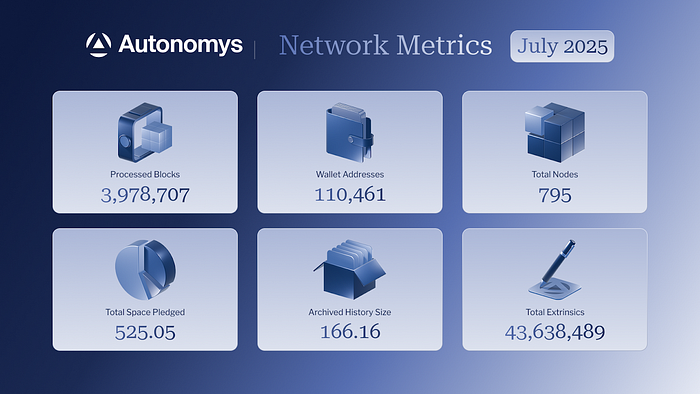
[ View More ]

Phase-2 Launch Readiness
- Security milestone achieved. SR Labs concluded its latest continuous security assurance on Autonomys, covering domains, XDM, fraud-proof pipeline, Proof-of-Time, and Proof-of-Archival-Storage. All critical findings were addressed, clearing the path to Phase-2 and ongoing security enhancements, including a bug bounty program.
[ SR Labs Audit ] - Token transferability has been enabled. With the audit completed, the network advanced to Mainnet Phase-2 transfer enablement on July 16th (16:00 UTC).
[ Transfer Enablement ] - Auto EVM Launched: Phase-2 introduces the Auto EVM for permissionless smart-contract deployment, aligning execution with the DSN for AI-native use cases.
- Operator & Staking Pathway: With Phase-2, operators and nominators move toward the live fee-for-compute model across domains, laying the groundwork for builder-facing apps and agent workloads.

Onboarded Partners
Autonomys is pleased to announce the following partnerships:
- Heurist
A decentralized AI-as-a-Service platform pioneering composable intelligence and privacy-preserving infrastructure for agent economies.
[ X ] | [ Blog ] - Fireverse
A decentralized music platform reimagining how music is created, owned, and monetized through AI and Web3 technologies.
[ X ] | [ Blog ] - PAI3
The infrastructure layer for decentralized AI, where containerized AI modules, decentralized inference, and a tokenized reward layer power the AI sharing economy. The collaboration will support PAI3’s encrypted data workflows with permanent on-chain storage via Auto Drive.
[ X ] | [ Blog ]
Technical Integrations Update
- Autonomys Bridge
New Bridge Route Added: Taurus Auto EVM ↔ BSC Testnet
A new testnet route has been added to the Autonomys Bridge on Taurus Auto EVM. You can now bridge assets between Taurus Auto EVM and the BSC (Binance Smart Chain) Testnet via Hyperlane.
[ X ] | [ Bridge ] | [ Details ] - SubWallet
$AI3 is now supported in SubWallet’s desktop app extension and mobile app, making it easier than ever to view, send, and receive tokens on Autonomys. SubWallet users can now seamlessly manage assets on Autonomys, an AI-native Layer 1 purpose-built to support modular, on-chain agents and super dApps.
[ X ]
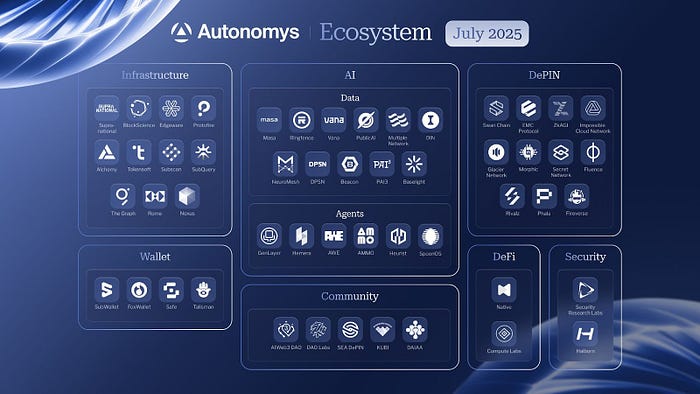

- Our Evolution from Subspace to Autonomys
Autonomys began with a shared vision: the future of the internet requires a decentralized, community-owned foundation that preserves data permanently, scales without compromise, and invites global participation without privilege.
[ X ] | [ Blog ] - Monthly Docs Contest
Did you know Autonomys hosts a Monthly Docs Contest that rewards contributors for improving our official documentation? Whether you’re clarifying technical flows, enhancing onboarding guides, or tackling open issues, the best and highest-quality merged pull requests are recognized and rewarded monthly.
[ X ] | [ Forum ] - Mainnet Phase-2 Activated
To mark this milestone, the Foundation hosted a Mainnet Phase-2 Launch Party via livestream covering several core topics: transfers were enabled live, the Dawn of Autonomy community campaign was introduced, updates delivered on domains, discussed exchange listing plans, announced a new grants program, and expanded on our ecosystem growth strategy.
[ X ] | [ YouTube ] | [ Recap Blog ] - Dawn of Autonomy
To celebrate the launch of $AI3 token transfers on the Autonomys Network, we kicked off an activation campaign. This is designed to honor early contributors and welcome new explorers.
[ X ] | [ Forum ] - Node Atlas Campaign
A four-week hunt for the most creative insights hidden in the Autonomys node map. The goal is to uncover and share unique patterns, facts, or quirks about our global nodes, highlighting intriguing things others might have missed.
[ X ] | [ Forum ] - Ecosystem Grant Program
As Autonomys moves from infrastructure delivery to ecosystem enablement, the Subspace Foundation is preparing to launch the Ecosystem Grants Program, supporting builders and advancing the network across infrastructure, agents, integrations, research, and growth.
[ X ] | [ Blog ]

- Phase-2 Mainnet Roadmap
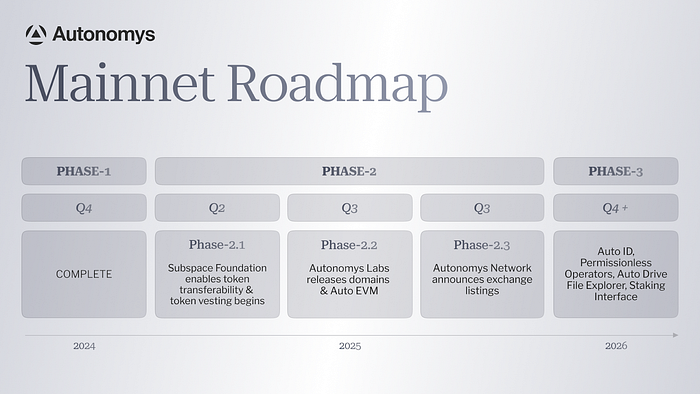
With the Phase-2 launch complete, August will be the month we shift from preparation to activation. The immediate priorities are:
- Token Transfers Live: Enablement on mainnet opens the door for on-chain liquidity, market access, and CEX integrations.
- Production Domain Deployment: Auto EVM will be fully operational, giving developers a scalable, composable execution layer to build AI-native applications.
- Ecosystem Grant Program Kick-Off: Funding rounds will open to support infrastructure providers, AI-powered dApps, and integration partners.
- Exchange & Liquidity Readiness: Finalize CEX integrations, prepare liquidity provisioning, and coordinate with market makers ahead of trading commencement.
- Builder Onboarding: Early ecosystem partners will begin deploying, testing, and scaling their solutions on Autonomys.
These steps will carry us from a secured, fully-audited protocol into an open market-ready, and scalable network, allowing Autonomys to serve as the foundational execution and storage layer for AI3.0.
[ Forum ]

July was an exciting and defining month for Autonomys. After years of research, engineering, and community building, this marked the moment our vision became a tangible, unstoppable, and economic reality.
The past few weeks have capped a series of major milestones: completing our audits, activating token transfers at the protocol level, and deploying our domains architecture to serve as the execution environment for our AI3.0 thesis. With the launch of our first domain, the Auto EVM, developers can now build and deploy composable applications tailored for AI-native workloads. In its first month, the ecosystem grants program has already received over a dozen applications, as it begins welcoming builders to contribute to the network. In parallel, the Subspace Foundation has been finalizing multiple exchange integrations, including a partnership with a tier-1 trading venue. We fully anticipate that trading will commence in the month of August.
As we look ahead, we’re exploring opportunities that could shape the long-term trajectory of Autonomys. We continue to believe that decentralized identity will play a critical role in AI alignment, enabling trust, accountability, and user ownership in autonomous systems. Advances in computing are also prompting us to consider post-quantum resistance as an inevitable requirement in securing AI-driven infrastructure. Alongside these, we’re investigating new approaches to scalability to ensure the network can meet the demands of next-generation workloads. We look forward to sharing our discoveries with you, none of which would be possible without our partners and community. Thank you for your continued support.
— Todd Ruoff
[CEO, Autonomys]
[ X ] | [ LinkedIn ]
Autonomys x Baselight: Bringing Structured, Transparent Data to the Agent Economy
Structured, transparent data meets permanent storage and modular execution — empowering AI agents to think, learn, and act in real time.
Autonomys is pleased to announce a strategic partnership with Baselight, the permissionless data hub making structured, transparent datasets accessible and actionable — now paired with Autonomys’ permanent storage and modular execution for AI-driven agents and applications.
Key Aspects of the Partnership
Native Integration for Autonomys Users
Autonomys users — whether running agents, building applications, or experimenting with autonomous workflows — will be able to upload datasets directly into Baselight. These datasets can be analyzed through Baselight’s browser-based Structured Query Language (SQL) engine, remixed with other sources, and monetized through access-controlled licensing without additional infrastructure. With the Baselight Model Context Protocol (MCP) server integrated into Autonomys, agents can access live, queryable datasets in real time, request structured data, run contextual searches, and act on insights — all without developers writing custom integration code.
Indexing the Autonomys Chain
Together we are exploring ways to make Autonomys chain activity fully accessible within Baselight’s structured data environment. This would start with ingesting exports from the Autonomys explorer and expand into comprehensive indexing, enabling developers, researchers, and agent builders to analyze chain events, agent activity, and related datasets in one place — alongside other on-chain and off-chain sources.
Get Autonomys Network’s stories in your inbox
Join Medium for free to get updates from this writer.
Baselight as a Data Layer in the Autonomys Ecosystem
Baselight will operate as a dedicated data layer for agents and applications in the Autonomys ecosystem, giving developers instant access to curated datasets, analytics, and workflow integration. Agents could not only consume data but also write back derived datasets or analytical results, creating a feedback loop where agent-generated insights strengthen the entire ecosystem.
Community Benefits
This partnership closes the gap between agent frameworks and shared, trusted datasets — bringing developers and researchers a unified environment where data can be discovered, queried, monetized, and acted upon. It enables agents in the Autonomys ecosystem to operate with information that is both transparent and reusable, driving richer, more intelligent behaviors.
“With Baselight, everyone can be a data analyst. We’re removing as many barriers as possible that block everyday people from discovering new data-driven insights. Our partnership with Autonomys gives developers a new data layer worth building with.” — Henrique Moinz, CEO at Baselight
“This integration directly supports our vision for AI3.0 — equipping agents in the Autonomys ecosystem with access to live, structured, and transparent data they can use, learn from, and contribute to. It’s a foundational step toward an agent-driven internet.” — Jim Counter, Head of Ecosystem at Autonomys
Looking Ahead
This partnership sets the stage for agents in the Autonomys ecosystem to work with structured, transparent data in real time, transforming how information is discovered, queried, and applied. Developers can already begin experimenting by publishing datasets into Baselight or connecting agents through its MCP server. In the months ahead, expect to see Autonomys datasets available on Baselight, early agent integrations, and new opportunities for builders and researchers to contribute.
About Baselight
Baselight is the permissionless data hub powering the next era of intelligent computation and AI-driven discovery. Founded by experts in distributed systems, cryptography, and large-scale data infrastructure, Baselight enables anyone to publish, discover, query, and monetize structured datasets through a unified platform. It eliminates the friction of fragmented tools and locked-down data silos by combining data discovery, analytics, and transparent monetization in one composable protocol. With native support for AI agents and large language models, Baselight makes it easy to integrate structured data into autonomous workflows and real-time analysis. Designed for analysts, developers, researchers, and intelligent systems alike, Baselight brings structure, auditability, and collaboration to data workflows at scale.
X | LinkedIn | Discord | Blog | Docs | YouTube
About Autonomys
The Autonomys Network — the foundation layer for AI3.0 — is a hyper-scalable decentralized AI (deAI) infrastructure stack encompassing high-throughput permanent distributed storage, data availability and access, and modular execution. Our deAI ecosystem provides all the essential components to build and deploy secure super dApps (AI-powered dApps) and on-chain agents, equipping them with advanced AI capabilities for dynamic and autonomous functionality.
X | LinkedIn | Discord | Telegram | Blog | Docs | GitHub | Forum | YouTube
Domains Are Now Live: Introducing Auto EVM and the Modular Execution Layer for Autonomys
Autonomys Network has officially activated Domains on mainnet!
This milestone introduces a new class of decoupled execution environments — beginning with the deployment of the Auto EVM Domain — that are secured by Autonomys’ consensus layer and optimized for scalability, specialization, and verifiability.
Auto EVM is now live and fully operational. Developers can deploy smart contracts and interact with the Domain using familiar tools like MetaMask, Foundry, and Hardhat.
What Are Domains?
Domains are decoupled execution environments that serve as native, sovereign Layer-2 chains, tightly integrated with Autonomys’ Proof-of-Archival-Storage (PoAS) consensus.
Unlike monolithic blockchains, where execution and consensus compete for the same resources, Domains offload computation to isolated environments. This architecture enables:
- Horizontal scalability
- Application-specific runtimes
- Permissionless Domain creation via a consensus-layer transaction
Each Domain inherits finality, transaction ordering guarantees, and data availability directly from the consensus layer, ensuring both performance and verifiability without sacrificing decentralization.
Roles and Responsibilities
Autonomys introduces a multi-role architecture that supports Domain execution and consensus with clearly separated responsibilities:
Farmers
Farmers commit SSD storage to store provably unique segments of blockchain history. They secure the consensus layer through PoAS, but do not participate in smart contract execution.
Operators
Operators execute transactions and run Domain virtual machines (e.g., Auto EVM). They:
- Register and stake $AI3 to join a Domain’s Operator Registry
- Compete in stake-weighted leader elections to produce Domain bundles
- Submit execution receipts and Domain bundles to the consensus layer
- Are slashable upon provable misbehavior
Operators are rewarded with execution and storage fees based on their work done for the network, which are automatically re-staked at each epoch transition.
Nominators
Any $AI3 holder can nominate trusted operators by staking to their pool. For more staking information, please visit: https://subspace.foundation/.
Auto EVM: The First Domain
Auto EVM is the first Domain deployed to mainnet and supports the Ethereum Virtual Machine runtime.
- Explorer: https://explorer.auto-evm.mainnet.autonomys.xyz/
- Tooling: Compatible with MetaMask, Foundry, Hardhat
- Token Support: $WAI3 (wrapped $AI3) now live for use in EVM-based DeFi and tooling
- Composability: Supports integration with Safe (multisig), Hyperlane-based bridge to Ethereum, and widely-used indexing tools
Auto EVM provides a familiar development experience while being backed by a fundamentally new and verifiable infrastructure.
Domain Lifecycle: From Creation to Execution
Each Domain follows a well-defined, permissionless lifecycle:
Domain Creation
A developer creates a Domain by submitting a single consensus-layer transaction, including the Domain runtime and its genesis configuration — defining parameters such as block size, weight, and bundle limits.
Operator Staking and Election
Registered operators enter the VRF-based leader election each time slot. Elected operators produce Domain bundles containing:
- A proof of election
- An execution receipt referencing the previous Domain block
- Valid extrinsics and associated storage fees
Bundle Verification and Inclusion
Farmer nodes verify and gossip valid bundles across the network. When a consensus block is produced, it includes as many Domain bundles as can fit.
Domain Block Execution
Operators build and execute Domain blocks. Extrinsics are deduplicated, grouped by sender, and cryptographically shuffled to minimize Maximum Extractable Value (MEV) opportunities before being executed. Execution receipts are submitted for verification.
Challenging Faulty Execution
If an invalid receipt is observed, any node can submit a fraud proof. If valid, the offending receipt is pruned, and responsible operators are slashed and risk being removed from the Operator Registry.
The challenge window is currently ~1 day (14,400 Domain blocks).
Fee Distribution
Once a Domain block is confirmed:
- Storage fees are partially refunded based on the actual storage utilized within each accepted Domain bundle
- Execution fees are pooled and split among eligible operators

Why This Matters
The launch of Domains and Auto EVM is a foundational leap forward for Autonomys:
- Modular Scaling: Each Domain scales independently, with no global bottleneck.
- Application Specialization: Builders can deploy chains with tailored runtimes and configurations.
- Verifiable Compute: All execution results are cryptographically validated via execution receipts and consensus inclusion.
- Economic Alignment: Incentives across farmers, operators, and nominators ensure long-term sustainability and trust.
This is the architecture needed to support next-generation workloads — whether DeFi, gaming, identity, or decentralized AI (deAI) agents — on a foundation designed from first principles to promote decentralization.
What’s Next?
With Domains now live:
- Developers can deploy to Auto EVM using existing, familiar EVM tooling
- Anyone can stake or nominate operators using $AI3
- Builders can begin designing custom execution environments tailored to specific use cases
The Autonomys Network is now a composable, horizontally scalable infrastructure stack — ready for the demands of AI3.0 and on-chain agents.
More Domains will emerge over time, each powered by the same permissionless and verifiable execution framework.
Explore: https://explorer.auto-evm.mainnet.autonomys.xyz/
Learn: https://academy.autonomys.xyz/autonomys-network/decoupled-execution/domains
Build: https://develop.autonomys.xyz/
For additional information on the Autonomys architecture, watch our 4-minute explainer video: https://www.youtube.com/watch?v=9jTBihUeq70
To learn more about and apply for a Subspace Foundation Grant, visit:
https://subspace.foundation/grants
About Autonomys
The Autonomys Network — the foundation layer for AI3.0 — is a hyper-scalable decentralized AI (deAI) infrastructure stack encompassing high-throughput permanent distributed storage, data availability and access, and modular execution. Our deAI ecosystem provides all the essential components to build and deploy secure super dApps (AI-powered dApps) and on-chain agents, equipping them with advanced AI capabilities for dynamic and autonomous functionality.
X | LinkedIn | Discord | Telegram | Blog | Docs | GitHub | Forum | YouTube




